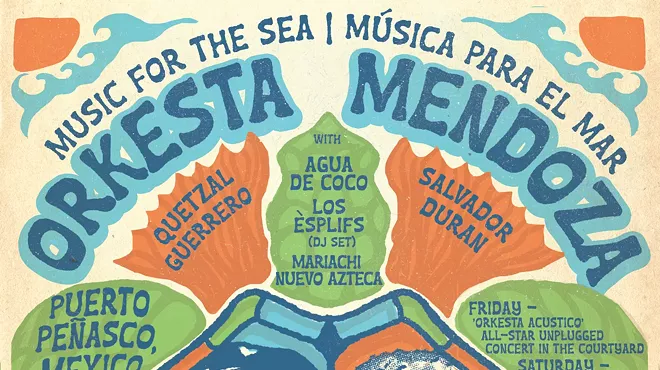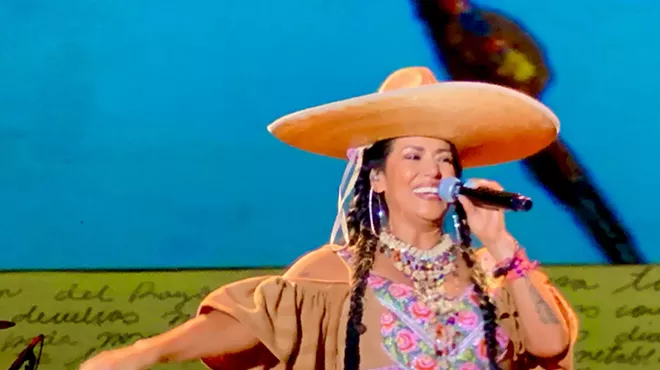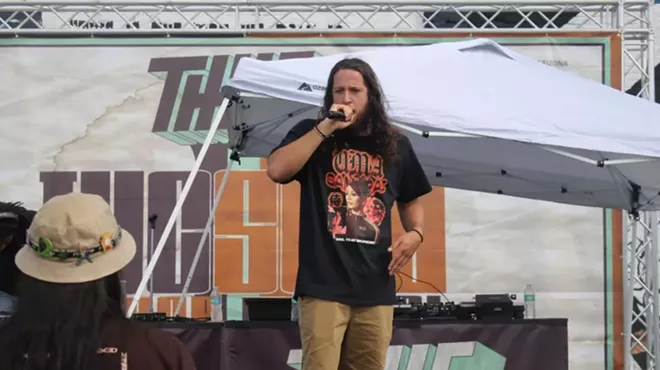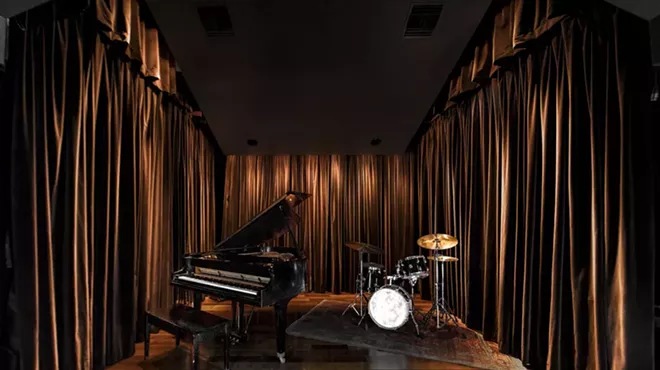Wednesday, April 16, 2014
More From Our Interview With Steve Roach
In last week’s issue, we spoke with ambient composer Steve Roach about the 30th anniversary of his landmark album Structures from Silence. Originally issued in DIY fashion on cassette by Roach himself, the three-song suite quickly gained notice. On April 15th, the album sees deluxe treatment courtesy Projekt Records. In addition to a clarity-enriching remastering job, the new edition features 2012 and ‘13 recordings by Roach that find him exploring the Structures sound and style from his Timeroom studio in the Sonoran desert south of Tucson.We ended up with more material than we could fit into the feature, so enjoy this extended Q&A with Roach and a sneak peek at his next project.
Tucson Weekly: I understand that you drove race cars in your youth?
Steve Roach: Growing up in Southern California in that era of the ‘70s — the whole spawn of the baby boomer wave — motocross was really kind of born in southern California. I was right where it was all emerging. If I wasn’t out hiking in the desert I really embraced this sport that was right in our backyard. It wasn’t as incongruent [with music] as you would think, because there’s a real kind of discipline you have to have. If you’re going to do it, you have to be fully awake and present. Your life depends on it. You’re completely in. You’re inside of it; your life depends on it. That set the tone.
That makes sense in relation to your music.
The thing that really shaped me in that time was a lot of time spent in the deserts outside of San Diego. Just in quiet, in silence, [listening to] desert sounds, the sound of the space itself. Tuning into that. My parents introduced me to that while world before I could drive. We’d go out desert camping, that sort of thing. We’d go out into the mountains of San Diego and to the ocean. So later on when I was able to start driving myself to these places, I might start out in the mountains mid-day and watch the sunset at the ocean. Those kinds of landscapes and atmospheric dynamics set the tone early on for me as an artist in terms of the kinds of spaces I wanted to be in and draw from.
What were you listening to then?
A lot of European music: Klaus Schulze, Tangerine Dream, Amon Düül, Popul Vuh; all that sort of music that had grown out of the sixties experimentation. There was a real psychedelic quality to it.I was drawn to the more progressive stuff, [like] Pink Floyd and Yes, but that music still felt pretty tethered down to the ground. I wanted something that was more expansive, that started moving beyond your perception of time. That’s when I discovered Timewind by Klaus Schulze, with 30-minute songs on both sides
Your first two records, Now and Traveler show that German space music influence most clearly.
With Now and Traveler I made a conscious decision: I wanted to create shorter pieces. Rather than do these 30-minute sides, I wanted to create songs that were like stops on a road — like Tucson, on to Phoenix, on to San Diego, to Santa Barbara, to San Francisco, to Portland and on to Vancouver. I wanted to that feeling of a journey across an album.
After making albums that focused on shorter pieces, you shifted into longform composition with Structures from Silence in 1984.
Yeah. Early into my career, I was making deliberate choices about doing shorter pieces, and then here comes [title track] “Structures from Silence.” It has no references to anything I had been listening to from Europe. It wasn’t the repetitive sequencer-style stuff we’d been hearing from Tangerine Dream and Kraftwerk and all that. Structures is where influence of my environment really took over in my work — [tapping into] the space you find yourself in when you’re in the desert and time slows down, your sense of awareness gets expands and is magnified. That sort of thing was very consciously coming into the music. I was making drives from Los Angeles — where I’d moved to do electronic music — to Joshua Tree, and then bringing that feeling back.
How long did you work on Structures?
The pieces were recorded over a year. I wasn’t thinking, “I’m going to make an album of this.” I was just recording and living in it. . My little place in Culver City was pretty much a 24/7 laboratory. I’d get off work and be right back into the studio, step right back into this space.After a year, I had those three tracks. I had more tracks, but those three tracks found themselves together on a cassette tape. I thought, “This fits.” The songs had that feeling.At that point, the Oberheim polyphonic synthesizer had emerged. The early polyphonic synthesizers just hadn’t been available previously, to do something of that lush nature. It was almost like I’d been waiting for them to build that instrument. I knew guys at Oberheim, and I’d go over there while they were designing it. It was almost like I was waiting for them to take it out of the oven, you know? I’d play early versions, and get to hear it.
And those sounds influenced what you wanted to make?
Yeah, those sheets of harmonic waves of warmth. Lush, perfect dark purple you want to wrap yourself in. I knew those instruments were coming, so I was envisioning the material I wanted to draw from it. But you know, that’s the same instrument Van Halen used on “Jump.”
The instrument was being used by different people in very different ways.
All at once, yeah. I remember being at Oberheim and one of the Jacksons was there picking one up. Dan Fogelberg, or some guy like that was there. Edward Froese of Tangerine Dream was over there getting one. We were all drawing on this instrument that we were going to take and do something all our own.
Brian Eno’s Music for Airports and Structures from Silence are often discussed in conjunction as early examples of ambient music. Were you familiar with Eno’s work?
I certainly was familiar with it. The first album I heard from him was No Pussyfooting, an album he made with Robert Fripp. That was my introduction. I appreciated it, as part of this new world, but it wasn’t an album that spoke to me. At that time I was already envisioning something I needed to create. I was a lot less tolerant of something that was off in a more abrasive and intense kind of realm. It was cool, but my focus was directed. Of course, Music for Airports was a whole beautiful revelation. But those records were signposts that I was already moving in a direction that was on that plateau, in that world. So when I heard them it was a validation, that this is happening simultaneously. But I didn’t consciously take cues from it.
Your music quickly became associated with the new age musical movement. Were you thinking about composing music for meditation or healing? Were you considering applications for your recordings, or were you more interested in tone?
I guess you could say I “composed” the music, but really I’m in the room with these instruments, playing and responding and creating something, and it’s really…I keep going back to painting. When you’re painting you look at it from different angles, and observe the way the light changes through the day. All that stuff influences the piece.
Structures was the point where that whole space was born out of me, brought into form. The first piece, “Reflections in Suspension,” that was recorded completely live, directly to two-track with no overdubs. You’re hearing it as it’s occurring. It’s like taking a photograph, like Ansel Adams or something — you’re photographing a moment, and when you look at it you’re transported to that exact moment in time. It’s not like I was looking at it saying, “If I add a little bit more of this delicate harp-like sound with delay it’ll really fit into that healing component for the new age genre.”But then there’s the other side, the healing nature of music, and that’s completely valid and important. [That’s] using music as a powerful tool for consciousness. I’m all about that… your body can become almost a tuning fork, tuned to certain emotions, openings, and feelings that you get from sound. If you’re tuned that, that music is going to start to find its way out into those places in the world. And it did naturally. Many letters came in from families that were using Structures in hospice programs for people moving on, and for children being born. You’ve got both ends of the spectrum, and between that you’ve got people using it to slow things down — breathing, yoga, things like that. So much of what I do becomes a tool, but the core origin of it all is me wanting to create these resonant sonic spaces I can live in, extracting some essence you get from nature, putting it under a microscope, and blowing it up on a big 70-millimeter screen.
Tags: steve roach , steve roach tucson , structures and silences , Video










